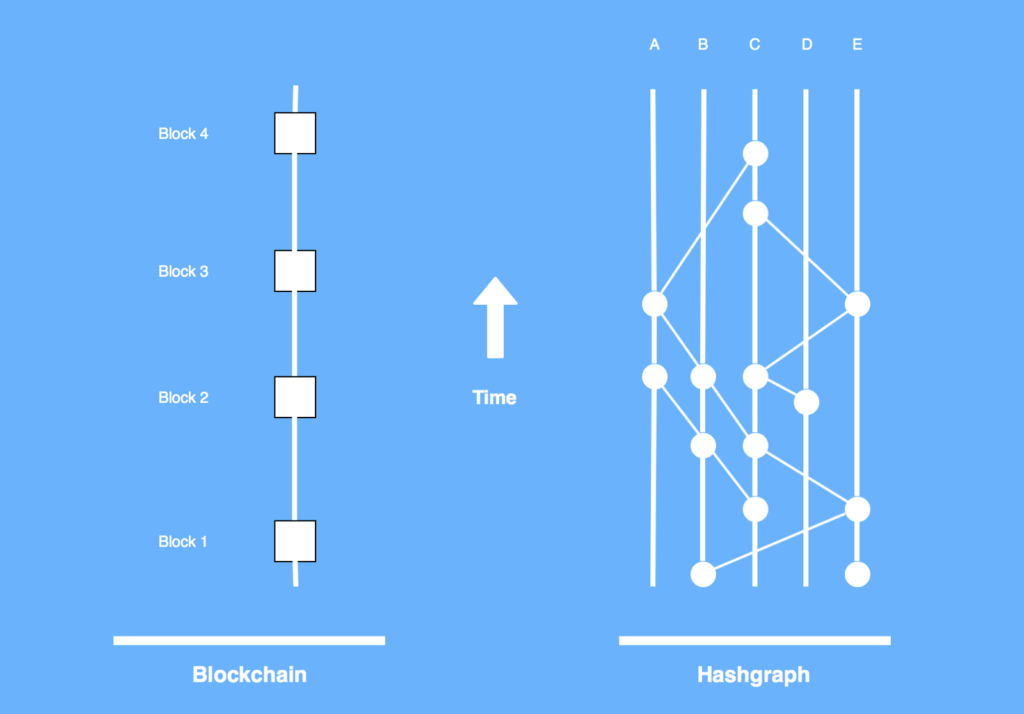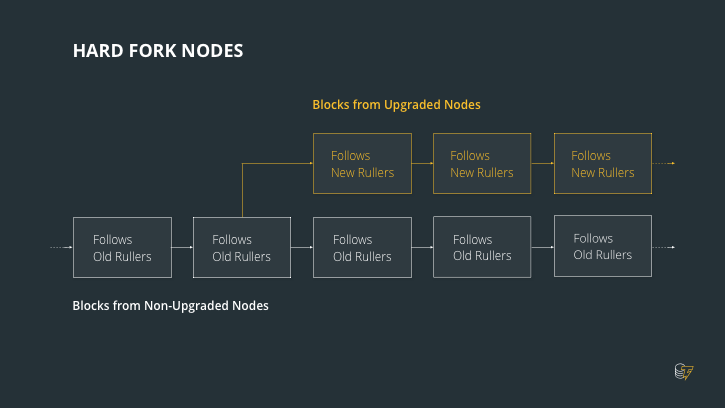
For this week podcast we continue our theme on how to build effective governance solutions in a blockchain ecosystem. This time we had the pleasure of having Mance Harmon, CEO of Hedera join us to share his insights on how to build effective governance.
What is blockchain?
At a very high level, blockchain is an evolution of database technology. In traditional database technology you can have a multi master database solution, which is essentially like having multiple copies of a same master database. It’s a replicated database with identical information in every instance. As users connect to these master databases to make updates to them you sometimes have what is called a write conflict. Meaning that the collection of all these databases need to come to an agreement on which one of those master databases was modified first. The assumption has always been that one organisation would manage all of those master databases. Whilst that may be fine in some scenario it doesn’t quite work in one where for example you’d ask Amazon to take one of its masters from its multi master database solution and give it to Google to run and administer.
What blockchain initially provided was for the first time the ability to take this multi master database solution and give away the masters to different legal entities, different organizations and do so securely. The 1st generation of blockchains, Bitcoin being an example of them, uses a very linear process. Each node in the network has a local copy of this chain and as new blocks get published the community decides which blocks to put on top of the chain and what order and everyone does that in this sort of linear fashion. For Mance this isn’t very efficient.
Difference between Hashgraph and Blockchain?
Hashgraph like blockchain is a form of distributed ledger technology (DLT). However unlike blockchain it doesn’t have a chain of blocks. Hashgraph is a graph that represents the flow of transactions, changes to the database across the network as well as an algorithm for determining which of these transactions to apply in a given order.
A hashgraph is a patented algorithm that promises the benefits of the blockchain, distribution, decentralisation and security through the use of hashing, without the drawback of low transaction speed.
While Bitcoin allows for approximately 5 transactions per second and Ethereum allows for approximately 15 transactions per second, a hashgraph can process thousands of transactions per second.
Hashgraph can achieve such speed and security because it adds a tiny amount of information on top of any transaction between databases. That tiny amount of information, or metadata, essentially keeps. A record of the last received transaction and the last one created. By taking those metadata one can build a picture of the flow of information within a network.
What is governance?
Governance refers to the process that a governing body goes through to determine what the product roadmap will be? What features are going to be added to the product? When those features will go to market? What rates are paid to the nodes in the network for their participation? What the fees are for the use of the network?
Governance can be thought of by using different model points as reference points. On one end you’ve got a dictatorship model where one person is calling the shots whilst on the other you have a full democracy.
Governance council type of model
A council type model is an alternative approach. Just like you wouldn’t have every person that holds a US dollar to be voting on monetary policy. However, a council of experts on monetary policy to be governing the money supply can work.
A governance council type of model is one where you have a large population that votes and a subset of the population that acts as experts of the council to making complex decisions. That is the model used by Bitcoin for example where you have 11 or 12 core developers deciding what goes into Bitcoin.
Differences in governance between open source blockchain and private blockchain
The problem in the public blockchain market is that everything is open-source, and what that means practically, is that the governing council whatever form that takes doesn’t have any teeth. They can’t actually compel the nodes in the network to actually adopt the changes that they’re proposing. If there is disagreement around the nature of those changes then a portion of that public blockchain may choose to split or hard fork of the network and go create their own.
A good example of this is when Bitcoin Cash decided to hard fork out of Bitcoin. See Coin Telegraphs article about this fork.
Whilst forks have fostered innovation they also represent a certain level of risk for business manager considering building enterprise applications on top of a platform that may fork.
In a private blockchain network the governing body grants permission to players to enter the network and issues them with the relevant rights to participate in. In such a network the governing body has the necessary teeth to govern.
Hashgraph’s governance approach
Hashgraph as an algorithm is patented. Whilst it has similarities to open source it is not open sourced. As open source project is open to review, it is transparent, accessible and has no licensing requirements to use.
However, due to its patent it has a governing body that has the authority to compel the nodes within the market to adopt the changes that the governing body decides upon. The governing body has legal controls and technical controls to compel the nodes in the network to adopt the upgrades and to prevent the network from hard forking or splitting into competing networks. These controls ensure for the first-time stability in a public distributed ledger network that hasn’t previously existed.
When building the governing body Mance took inspiration from Dee Hock, founder of the Visa Network back in the 1960s and author of the book “One from Many: VISA and the Rise of Chaordic Organization”.
39 global blue chip organisations with the largest market capitalisation chosen across 18 sectors of the global market to ensure broad distribution across all sectors and geographically distributed. Each of them are term limited to ensure they aren’t council members for life. They are members of a corporation with real teeth. Hedera Hashgraph is an LLC, a Delaware based LLC and these council members are formal members of the LLC. So, there is a board of managers for example that has five representatives selected from the 39 and the board of managers have the authority to hire and fire the CEO, Mance Harmon.
The 39 blue chip organisations select 5 members of a board of managers who are responsible for day to day matters in order to ensure quick responses. In addition to the board of managers, there are committees such as a technical steering committee, a legal and regulatory committee and a marketing committee for example. Each committee have oversight over the relevant operations of the company but they are not operational. They do however help decide product roadmap and policy for example.
Once a blue chip organisation term is ended a membership committee that is made up of some of the 39 members will look at potential replacements and make recommendations to the 39 at large and then vote on who they want to invite into the committee.
In the future Mance predicts they will have participating organisations that will be able to make contributions but won’t be able to vote. Those participating organisations will also form a clear pool of possible replacements for the governing members when their terms ends.
Governance learnings from running both a public and private blockchain
Hedera Hashgraph initially started off as Swirlds a blockchain platform for permissioned networks for enterprises. Mance and Leemon then also created Hedera Hashgraph as a public ledger.
Private blockchains are a lot easier than public ones. Public blockchains have cryptocurrency which means there are legal and regulatory issues that need to be addressed. A global governing body is required to look at legal and regulatory issues in every jurisdiction. A private network doesn’t have a cryptocurrency associated with it and in general it’s a smaller group with a set of bylaws to govern themselves.
However, Mance points out that the way Hedera Hashgraph is set up it more closely resembles private blockchain networks in the manner that they are governed.
In general, public blockchains have governing challenges due to their lack of teeth to enforce changes to the code with open source. Mance doesn’t believe that long term public networks will succeed if they’re always trying to persuade the members of the community to adopt the latest set of changes. It’s governance through crisis, where progress is made forward only through crisis.
Top tips for creating a blockchain ecosystem
In creating a private network the top tip is to get as many of the potential members of the ecosystem involved as early as possible because there are lots of subtleties in the governance bylaws that have to be worked out. It helps in getting the members buy into the eventual governance set of bylaws.
Your Turn
Thank you Mance for sharing some great insights on how to build effective governance solutions within a blockchain ecosystem. If you liked this episode, please do review it on iTunes. If you have any comments or suggestions on how we could improve, please don’t hesitate to add a comment below. If you’d like to ask Mance a question, feel free to add a comment below and we’ll get him over to our site to answer your questions.









2 comments on Ep.54 – Building effective governance in a blockchain ecosystem – Insights from Hedera Hashgraph Network